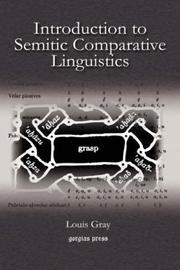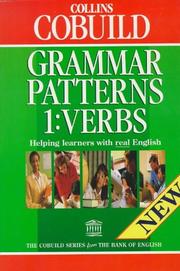| Listing 1 - 10 of 8518 | << page >> |
Sort by
|
Book
ISBN: 0520022106 9780520022102 Year: 1973 Publisher: Berkeley (Calif.): University of California press,
Abstract | Keywords | Export | Availability | Bookmark
 Loading...
Loading...Choose an application
- Reference Manager
- EndNote
- RefWorks (Direct export to RefWorks)
Book
ISBN: 8476354738 9788476354735 Year: 2016 Publisher: Madrid: Arco/Libros,
Abstract | Keywords | Export | Availability | Bookmark
 Loading...
Loading...Choose an application
- Reference Manager
- EndNote
- RefWorks (Direct export to RefWorks)
Book
ISBN: 311145763X 3111090272 Year: 1907 Publisher: De Gruyter
Abstract | Keywords | Export | Availability | Bookmark
 Loading...
Loading...Choose an application
- Reference Manager
- EndNote
- RefWorks (Direct export to RefWorks)
To celebrate the 270th anniversary of the De Gruyter publishing house, the company is providing permanent open access to 270 selected treasures from the De Gruyter Book Archive. Titles will be made available to anyone, anywhere at any time that might be interested. The DGBA project seeks to digitize the entire backlist of titles published since 1749 to ensure that future generations have digital access to the high-quality primary sources that De Gruyter has published over the centuries.
Book
ISBN: 9788386881505 Year: 2008 Publisher: Opole : Uniwersytet opolski. Instytut filologii polskiej,
Abstract | Keywords | Export | Availability | Bookmark
 Loading...
Loading...Choose an application
- Reference Manager
- EndNote
- RefWorks (Direct export to RefWorks)

ISBN: 1463211074 1593331967 Year: 2019 Publisher: Gorgias Press, LLC
Abstract | Keywords | Export | Availability | Bookmark
 Loading...
Loading...Choose an application
- Reference Manager
- EndNote
- RefWorks (Direct export to RefWorks)
Although it is a discipline with a venerable heritage, comparative Semitic linguistics has long suffered from the difficulty of finding an introduction that does not already require a specialists’ knowledge of the field. The primary languages Gray selected were Hebrew, the language most Semitic readers begin with, and Arabic, the most widely known Semitic language. The result is this user-friendly introduction.
Book
ISBN: 9027259844 9789027208828 9027208824 Year: 2021 Publisher: monograph
Abstract | Keywords | Export | Availability | Bookmark
 Loading...
Loading...Choose an application
- Reference Manager
- EndNote
- RefWorks (Direct export to RefWorks)
"Adpositions are used, universally, to mark the roles of nominal participants in the verbal clause most commonly indirect object roles. Practically all languages seem to have such markers which begin their diachronic life as lexical words -- in this case either serial verbs or positional nouns. In many languages, however, adpositions also seem to have extended their diachronic life one step further, becoming verbal affixes. The main focus of this book is the tail-end of the diachronic life cycle of adpositions. That is, the process by which, having arisen first as nominal-attached prepositions or post-positions, they wind up attaching themselves to verbs. Our core puzzle is thus fairly transparent: How and why should morphemes that pertain functionally to nominals, and begin their diachronic life-cycle as nominal grammatical operators, wind up as verbal morphology? While the core five chapters of this book focus on the rise of verb-attached prepositions in Homeric Greek, its theoretical perspective is broader, perched at the intersection of three closely intertwined core components of the study of human language: (a) the communicative function of grammar; (b) the balance between universality and cross-language diversity of grammars; and (c) the diachrony of grammatical constructions, how they mutate over time.While paying well-deserved homage to the traditional Classical scholarship, this study is firmly wedded to the assumption, indeed presupposition, that Homeric Greek is just another natural language, spoken before written, designed as an instrument of communication, and subject to the same universal constraints as all human languages. And further, that those constraints--so-called language universals--express themselves most conspicuously in diachronic change. In analyzing the synchronic variation and text distribution of prepositional constructions in Homeric Greek, this study relies primarily on the theory-laden method of Internal Reconstruction"--

ISBN: 9780003750621 0003750620 0003750515 Year: 1996 Publisher: London: Harper Collins,
Abstract | Keywords | Export | Availability | Bookmark
 Loading...
Loading...Choose an application
- Reference Manager
- EndNote
- RefWorks (Direct export to RefWorks)
Book
ISBN: 3110755467 3110754983 Year: 2021 Publisher: Dusseldorf : Walter de Gruyter GmbH,
Abstract | Keywords | Export | Availability | Bookmark
 Loading...
Loading...Choose an application
- Reference Manager
- EndNote
- RefWorks (Direct export to RefWorks)
This series Dissertations in Language and Cognition explores issues of mental representation, linguistic structure and representation, and their interplay. The research presented in this series is grounded in the idea explored in the Collaborative Research Center The structure of representations in language, cognition and science (SFB 991) that there is a universal format for the representation of linguistic and cognitive concepts.
Book
ISBN: 9780192652423 9780192897749 0192897748 Year: 2022 Publisher: Oxford, United Kingdom: New York, NY: Oxford University Press,
Abstract | Keywords | Export | Availability | Bookmark
 Loading...
Loading...Choose an application
- Reference Manager
- EndNote
- RefWorks (Direct export to RefWorks)
This volume draws on insights from a range of theoretical perspectives to explore objects, agreement, and their intersecting angles, based on novel data from multiple language families. The recent expansion of agreement theories has revealed new ways of integrating phenomena that affect objects and their relational and featural properties with conventional object markers, under a single 'agreement' umbrella. The contributions to this book present the major advances in these new angles of research into object agreement, and highlight in particular the shared conditions on objects undergoing agreement that are attested in a large number of genetically unrelated languages and language modalities. Following a detailed introduction, the chapters are organized into four parts that explore respectively the mechanics of object agreement, constraints on symmetry, features of object agreement, and issues relating to the left periphery. The volume's findings and the novel questions that they raise will be of interest to theoretical linguists, typologists, sign language researchers, and anyone working on the theoretical analysis of Amazonian, Bantu, Romance, Semitic, and Slavic languages.
Book
Year: 1976 Publisher: Cambridge (Mass.): MIT Press,
Abstract | Keywords | Export | Availability | Bookmark
 Loading...
Loading...Choose an application
- Reference Manager
- EndNote
- RefWorks (Direct export to RefWorks)
| Listing 1 - 10 of 8518 | << page >> |
Sort by
|

 Search
Search Feedback
Feedback About UniCat
About UniCat  Help
Help News
News